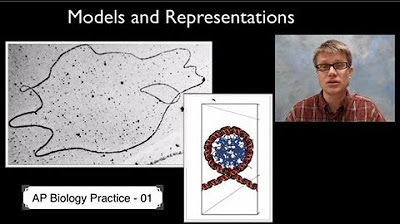2.6 Membrane Transport - AP Biology
Summary
TLDRIn this engaging AP Biology lesson, Mr. Poser delves into membrane transport, building on previous topics of cell structure and membrane permeability. He explains key concepts such as diffusion, concentration gradients, and the significance of passive and active transport mechanisms. Mr. Poser uses relatable metaphors to illustrate these processes, emphasizing the importance of maintaining concentration gradients for cellular function, particularly in neurons. He concludes with a discussion on exocytosis and endocytosis, highlighting how cells import and export large molecules. This foundational knowledge sets the stage for understanding more complex biological processes.
Takeaways
- 😀 Diffusion is the movement of molecules from high to low concentration until equilibrium is achieved.
- 📈 A concentration gradient is established when there is a difference in the density of a substance across a barrier.
- 🌊 Cells rely on diffusion to bring in nutrients and remove waste effectively.
- ⚡ Passive transport occurs naturally without the use of cellular energy (ATP), allowing molecules to diffuse across the membrane.
- ⛰️ Active transport requires energy to move substances against their concentration gradient, similar to going uphill.
- 🔄 The phospholipid bilayer is selectively permeable, regulating what enters and exits the cell.
- 🚪 Exocytosis is a process where cells secrete large molecules by fusing vesicles with the plasma membrane.
- 🧪 Endocytosis involves the cell engulfing large molecules by forming vesicles around them.
- 🍽️ Phagocytosis is a specific type of endocytosis that deals with solid food particles ('cell eating').
- 💧 Pinocytosis is another form of endocytosis focused on the uptake of extracellular fluids ('cell drinking').
Q & A
What is diffusion, and why is it important for cells?
-Diffusion is the tendency for molecules to spread out from areas of high concentration to areas of low concentration. It is essential for cells as it allows them to bring in nutrients and expel waste products.
What is a concentration gradient?
-A concentration gradient refers to a region where the density of a substance increases or decreases. It exists when there is a difference in the concentration of molecules on either side of a membrane.
What does equilibrium mean in the context of cell membranes?
-Equilibrium occurs when the concentrations of molecules on either side of a membrane are equal, meaning there is no net movement of molecules across the membrane.
How does passive transport differ from active transport?
-Passive transport occurs naturally without the expenditure of energy, while active transport requires energy (in the form of ATP) to move substances against their concentration gradient.
What is facilitated diffusion?
-Facilitated diffusion is a process where molecules pass through the cell membrane via protein channels or carriers, allowing substances that cannot diffuse freely to enter or exit the cell.
What role do ATP and membrane proteins play in active transport?
-ATP provides the energy needed for active transport, allowing membrane proteins to move substances against their concentration gradient, thus maintaining essential concentration gradients within the cell.
What is exocytosis, and how does it function?
-Exocytosis is a form of active transport where vesicles containing molecules fuse with the plasma membrane, releasing their contents outside the cell.
Can you explain endocytosis and its types?
-Endocytosis is the process by which cells take in molecules by engulfing them in a membrane bubble called a vesicle. The two main types are phagocytosis (the ingestion of solid particles) and pinocytosis (the ingestion of extracellular fluid).
What is the significance of selective permeability in cell membranes?
-Selective permeability allows cells to regulate what enters and exits, maintaining necessary concentration gradients crucial for various cellular functions, including nerve signal transmission.
How do concentration gradients relate to cellular metabolism?
-Cells rely on concentration gradients to bring in necessary substances like oxygen for metabolism while removing waste products like carbon dioxide, facilitating efficient cellular processes.
Outlines

This section is available to paid users only. Please upgrade to access this part.
Upgrade NowMindmap

This section is available to paid users only. Please upgrade to access this part.
Upgrade NowKeywords

This section is available to paid users only. Please upgrade to access this part.
Upgrade NowHighlights

This section is available to paid users only. Please upgrade to access this part.
Upgrade NowTranscripts

This section is available to paid users only. Please upgrade to access this part.
Upgrade NowBrowse More Related Video

2.7 Facilitated Diffusion - AP Biology

7 Things to Know about DNA structure

2.10/2.11 - Compartmentalization/Origins of Compartmentalization - AP Biology

AP Biology Practice 2 - Using Mathematics Appropriately

3.1/3.2 Enzyme Structure + Catalysis - AP Biology

AP Biology Science Practice 1: Models and Representations
5.0 / 5 (0 votes)